
1. Introduction:
Objective: Pfizer have developed a new drug that appears to reduce the size of specific tumors but are concerned about what effect the drug might have on normal tissue. Outline how you would use DNA technology to address this issue.
Cancer disease has large complexities in terms of genome variations at genetic level and epigenetic level. Immortalization and tumor genesis are the two fundamental characteristics of cancerous cells. This disease is caused by mutations in genes such as oncogenes, DNA repairing genes and tumor suppressor genes. Recent researches suggested that more than one mutations are needed for the cancers. One of the major drawbacks of the medicines or drugs that are used to treat cancer is its side effects on normal cells. The cells which are mostly affected by drugs are rapidly dividing cells such as blood cells, hair follicles cells, cells found in tract of reproductive organ and digestive system, and cells from immune system. Side effects on normal cells due to chemotherapy has become major challenges for researchers. Transcriptome or protein expression profiling for cancerous cells treated with specific drugs may provide useful information about possible side effects on normal cells. When any drugs or medicines are given for the treatment of any specific tumor disease, it binds with specific receptors (cell surface receptors, Cytoplasmic receptors or nuclear receptors) and leads to transcription and translation process and generate specific proteins that can be able to stop the cell cycle or initiation of apoptosis. But generally these drugs may also responsible to translation of unwanted proteins that can cause side effects on normal tissues.
2. Approach:
Mode of action of many drugs that reduces the size of tumor are related to growth cycle (like mutagen, MAP kinase pathway) or DNA modifications (transcription, translation etc.). This method is more suitable for in vivo testing in rats or mammalian cancerous cell lines which has been described here. The added tumor size reducing drug must bind with specific receptors on the tumor cells. So first step is the identification of pathway via which it acts. In the downstream signaling of the pathway, some transcription factors will be activated and will bind to target promoter and reduces the size of tumor. So then transcription factors need to be quantified by qPCR as well as the sequence of their promoter through DNA Foot Printing. Now two plasmids need to be constructed (minimum two plasmids, if there are more transcription factors and promoters, more plasmids with different fluorescent proteins are needed) containing above identified promoter coupled with red fluorescent protein (RFP) and containing a tumor inducible promoter coupled with green fluorescent protein (GFP). Now for in vivo testing, mutant mouse are created and transfected with above two plasmids. During the growth, the known tumor inducing compounds/radiation is given to the mouse to induce the tumor. As the drug is added, it will cause induction of RFP through the body but level may be higher in tumor cells but GFP should be induced only in the tumor cells. If GFP is induced in other normal cells it means that this drug may cause side effect on that cells. A fluorescent mapping of mouse will reveal the efficacy and side effects of drug based on RFP and GFP intensity.
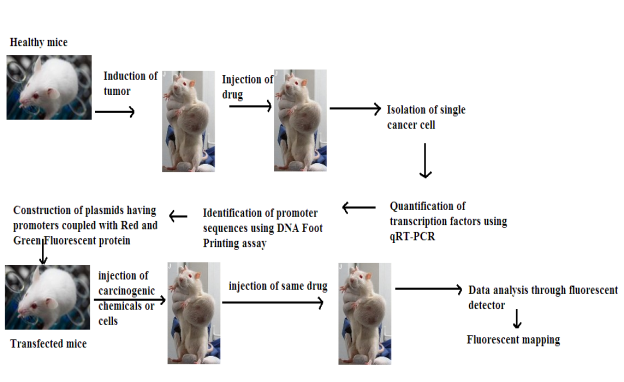
Figure 1: Schematic presentation of approach. The image of mice is taken from internet which has been used to explain the method.
3. Method:
This method is suitable for in vivo testing in mice or mammalian cells culture. The main steps include quantification and identification of transcription factors and promoter sequences respectively, construction of suitable plasmids coupled with red and green fluorescent proteins, transfection of plasmids in mice body, tumor induction in mice body followed by drug injection and last fluorescent mapping using fluorescent detector. The instruments and techniques which will be used in this methods are qRT-PCR, DNase Foot Printing assay, Suitable plasmids vector, microinjections, Chemicals, fluorescent proteins (red and green), capillary electrophoresis, tumor inducing cells or chemicals or radiation and fluorescent detector. Validation of this method is important so validation could be possible by using this method for any known drug which side effects on normal cells has been identified completely.
3.1. Quantification of Transcription Factor:
The exact quantification of transcription factor is the most important part of this method. Micro array or PCR is the good technique for quantification of transcription factors but in this method qPCR/QRT-PCR will be appropriate technique. First step is isolation of cancer cells from mammalian cancerous cell lines. Then inject target anti-cancer drug and incubate for some time because these drugs takes some time to start their function. After proper incubation, total or poly A RNA extraction is the next step. The solution which is used in extraction process should be RNase free otherwise it can degrade our RNA so that exact quantification could not be possible. Sample should be treated with DNase to remove genomic DNA contamination.
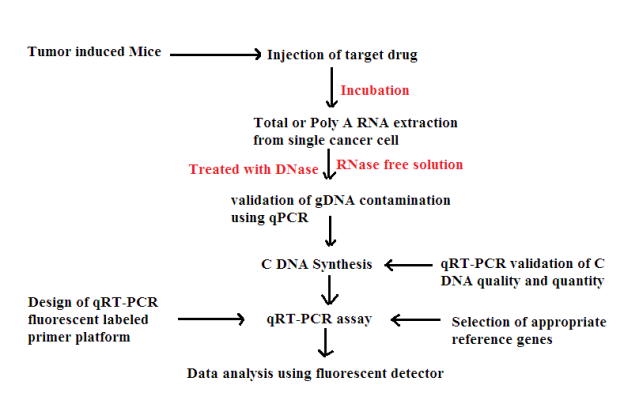 Flow Chart 1: Steps involved in quantification of Transcription factors
Flow Chart 1: Steps involved in quantification of Transcription factors
Electrophoresis and qPCR methods could be used for determination of purity and accurate concentration because these factors are very important for proper gene expression profiling. Then C DNA synthesis and validation of C DNA quality and quantity could be done by using qRT-PCR. For performing qRT-PCR assay there are two important steps such as selection of appropriate reference genes and designing of PCR primer labeled with fluorescent dye must be needed. For data analysis fluorescent detector can be used to detect transcription factors and their associated genes. Now once genes have been identified by using above method so the identification of their promoter sequence DNA Foot Printing assay will be performed.
3.2. Identification of Promoter Sequence:
DNase Foot printing assay method can be used to identify target promoter sequence. Steps involved in this method is amplification of target DNA through PCR using fluorescent labeled primer at 5’ end. Then cleavage of the amplified DNA by using DNase enzyme followed by the capillary electrophoresis. The cleavage pattern will vary due to the presence of transcription factor, because the binding sites are protected by the protein from the cleavage. By using this method we can identify the promoter sequences. By using capillary electrophoresis we can identify the amount and size of DNA fragments and about the bases which are not cleaved by the DNase enzyme.
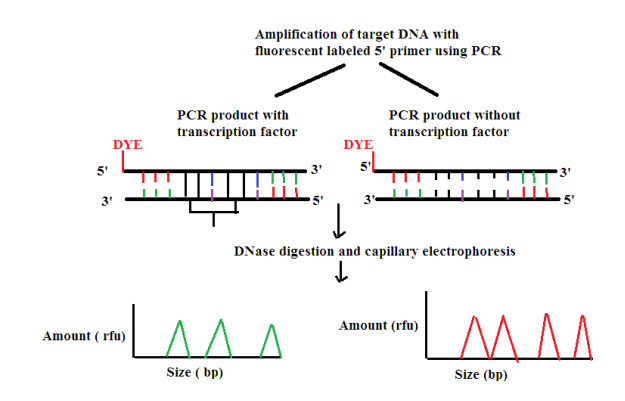
Figure 2: Identification of promoter sequences through DNA Foot Printing assay. The graph between amount and size of DNA fragments in this figure is showing the bases which are protected by the transcription factor against DNase enzyme.
3.3. Construction of Suitable Plasmids:
Construction of suitable expression vectors for mammalian cells, that can carry the desired promoter sequence coupled with fluorescent protein must be needed. The most important characteristics of vectors is presence of all elements that is suitable for expression in host cells. The important elements are promoter, stop and start codon, binding sites for ribosome, ORI region and appropriate selection markers. Some examples of vectors like adenoviral, PSV and pCMV are generally used for expression in mammalian cells. In this method, our expression vectors should contain promoter sequence labeled with red and green fluorescent protein and other important elements. Minimum two type of plasmid vectors need to be constructed. One plasmid should have promoter coupled with RFP which has not induced by the tumor inducible transcription factors. Other plasmid should have tumor inducible promoter coupled with green fluorescent protein. Our main idea is to inject these vectors into the mutated mice body so that we also need to remove the other elements of vectors that can cause any unwanted diseases in mutated mice. The vectors like pED and Pz can be used for the expression in mammalian cells.
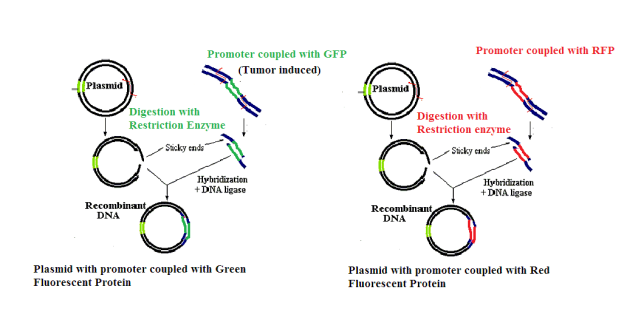 Figure 3: Construction of plasmids containing promoter coupled with Red and Green fluorescent protein.
Figure 3: Construction of plasmids containing promoter coupled with Red and Green fluorescent protein.
The very first step for the construction of the recombinant plasmid is the cleavage of both plasmid and target DNA with promoter sequence coupled with fluorescent protein using suitable restriction enzymes. The restriction enzymes creates sticky or blunt ends (depends on type of restriction enzyme used) in both plasmid and target DNA. Next step is the hybridization of both DNA and plasmid using DNA ligase enzyme. Selection of cells having plasmid with desired sequence is very important so further we need to selection of appropriate vector by using selection markers like antibiotic resistance genes.
3.4. Transfection:
The transfer of desired plasmid inside the mice body could be possible through many ways such as microinjection, electroporation, shotgun method, through chemicals and viral infections. Transfection through viral infection has some limitations like limited carrying capacity of desired gene and unwanted inflammatory mutations. However, transfection through viral infection have some advantages like easy to handle, easy preparation and easily monitoring during the process. So, in this method transfection of plasmid in mice should be done directly through microinjection into the mice body. One another way for transfection of recombinant plasmids in mice is through recombinant Baculovirus. Baculovirus infects insect cells. Purified budded virus can be isolate from the infected insect cells with recombinant Baculovirus. This purified budded virus can be introduced inside the mice body. For the study of side effects on normal cells in whole body of mice it is very important that this recombinant plasmids will reach every parts of body along with tumor affected parts.
3.5. Induction of Tumor in Mice:
Mammalian cancerous cell lines or cell DNA extracted from virally infected cells can be able to induce cancer in mice. Once theses tumorgenic cells is injected inside the mice body it develop specific tumor. After developing cancer in mice body, anti-cancer drug is administered through injection to show the efficacy and side effects on cancerous and non-tumor cells. When drugs binds with specific target receptors, it will induce both promoters but with varying intensity. The promoter coupled with RFP will show intensities in both normal and tumor cells but may be higher in tumor cells. But GFP should be induced only in tumor cells if it is inducing in other normal cells with high intensity then it may cause side effects on those normal cells.
3.6. Fluorescent Mapping:
Analysis of fluorescent mapping of these promoters in different locations of the mice body can provide useful information about possible side effects against designed anti-cancer drugs. For example if GFP will be induced in other cells like hair cells, heart cells, bone marrow cells than we can predict the side effects on these cells because the drug should not induce translational process in normal cells. If this drug induces promoters only in tumor cells then the chances of side effects may be less. We can study possible side effects against various drugs by using this method.
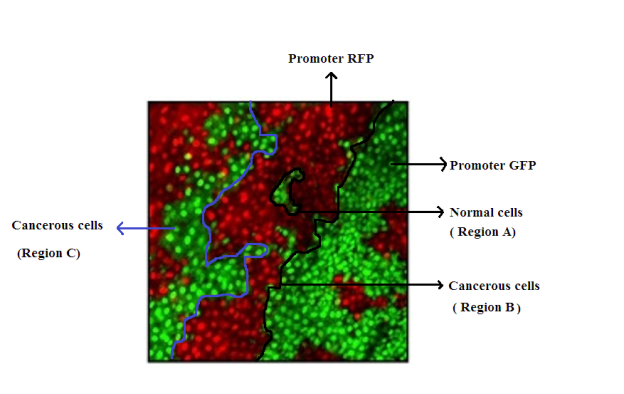
Figure 4: This picture has been modified for illustrating the possible results that can be produced by this method. Region B and C in this figure are representing the cancerous cells where GFP has been expressed. Region A is representing the normal cells where GFP has been also expressed so this drug may cause side effects on this cells.
3.7. Validation of the Method:
This approach has not been validated because this is the hypothesis only. For the testing of this method whether it is working efficiently or not need to be validated. An efficient approach has been described here. For the validation of this method we need to perform this method on known anti-cancer drugs for specific type of cancers. This method can be apply for known drugs which side effects on normal cells have been identified completely. If fluorescent mapping provide exact location in the body where GFP has been induced and if these locations are related with those areas where this specific drug causes side effects then this method will be validated. But proper validation need to be tested for various anti-tumor drugs which side effects has been completely known.
4. Discussion:
There are so many side effects associated with anti-cancer drugs because these drugs mainly affects rapidly dividing cells and immune system. The drugs or medicines that are currently used have always some common side effects like typhlitis, diarrhea and hair loss but sometimes these drugs cause serious side effects like liver damage and cardiac arrest because these drugs are unable to differentiate rapidly growing normal and cancerous cells. So that development of proper efficient method for testing possible side effects for any anti-cancer drugs should be developed. In this section a good approach has been described for the identification of possible side effects on normal cells. The idea is based on the role of transcription factors induced by the drug- receptors interactions. As instance certain anti-tumor drugs causes anemia when used for the treatment of specific tumor. Generally the gene called HBB is responsible for anemia because this gene encode beta globins protein. It means that these drugs also induces transcription factor that is responsible for activation of HBB gene. The fluorescent mapping of unknown anti-cancer drug against specific cancer can provides useful information about possible side effects. The figure 4 which has been modified to illustrate the possible results that can be achieved through this method. If the drug is not inducing GFP in normal cells except cancerous cells it means drug will not cause any side effects on normal cells but vice versa if GFP is expressing in other cells along with tumor cells so we can predict possible side effects on those cells because this method is also useful to find out what type of protein or transcription factors are expressed. By using bioinformatics data bases like PDB, Gene bank etc, functions of expressed proteins or transcription factors can be easily predict. The method which has been described above has not validate yet because this method is only a hypothesis that need further advancement and validation.
5. References:
You have to be 100% sure of the quality of your product to give a money-back guarantee. This describes us perfectly. Make sure that this guarantee is totally transparent.
Read moreEach paper is composed from scratch, according to your instructions. It is then checked by our plagiarism-detection software. There is no gap where plagiarism could squeeze in.
Read moreThanks to our free revisions, there is no way for you to be unsatisfied. We will work on your paper until you are completely happy with the result.
Read moreYour email is safe, as we store it according to international data protection rules. Your bank details are secure, as we use only reliable payment systems.
Read moreBy sending us your money, you buy the service we provide. Check out our terms and conditions if you prefer business talks to be laid out in official language.
Read more